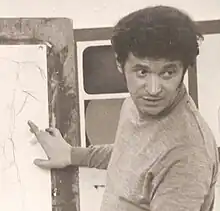Theo Stavropoulos | |
|---|---|
 Theo Stavropoulos c. 1970 | |
| Born | 3 June 1930 Athens |
| Died | 11 March 2007 (aged 76) Maine |
| Alma mater | |
| Occupation | Artist, painter |
| Website | https://theostavropoulosart.com/ |
Theo Stavropoulos (1930–2007) was a Greek American painter.[1]
Life and education
Born in Athens in June 1930, Stavropoulos lived in Greece during the Axis occupation, during which his parents became imprisoned. He entered art school when he was thirteen, was a member of the Greek Resistance,[1][2][3] and studied art with the surrealist painter Giorgos Gounaropoulos.[1]
After the war, he studied art in Paris with Fernand Léger,[4] and at Yale University with Josef Albers on a Yale University scholarship.[1][4] He received the Prix Lefranc in 1952.[4] He married in Athens in 1959, and by the early 1960s, the couple had a daughter and lived in New Haven, Connecticut.[4][3] By 1965, he had been exhibited in Europe and the US, and had designed the interior of a New Haven church.[2]
He taught at the University of Bridgeport and Lehman College,[3][5] where he worked for 25 years.[6]
In 1980, the gallery that represented him closed. From then on he showed his work only to family and friends, and so largely disappeared from public attention.[1] He died in his home Maine in March 2007.[3] In 2013, an exhibition of his work called Offerings of Light was held at the Lehman College art gallery.[1]
Art
Watertown Town Times said in 1965 that "His paintings are noted for a serene simplicity glowing with quiet color. His technique creates a synthesis between the Grecian ideal and modern western culture."[2] Arts Magazine said the same year "...semi-classical nostalgia infuses all of the paintings; ... scrapbooks of a clever expatriate well aware of art history."[7] The magazine commented in 1976 that some of his work were "... purposely ambiguous. One could not tell whether he was representing real figures of carvings in stone.", while newer works were "... more abstract; one could hardly recognize any of the objects except that they were lights."[8] In 1978, it said he was "...creating a kind of pictorial hybrid which seems to hover between the abstract and the real."[9]
Art critic Amei Wallach wrote in 2013 that Stavropoulos tested "the borders between reality and the dream".[1]
References
- 1 2 3 4 5 6 7 Greenwald, Xico (6 September 2013). "Artist's Calling". The New York Sun. Retrieved 16 January 2023.
- 1 2 3 "Art Exhibit To Feature Greece". Watertown Town Times. 1 July 1965. p. 6 – via NewspaperArchive.
- 1 2 3 4 "Theo Stavropoulos". Portland Press Herald. 14 March 2007. Retrieved 9 August 2023.
- 1 2 3 4 "GALLERY SHOWS THEO PAINTINGS". Bridgeport Post. 10 February 1963. p. 61 – via NewspaperArchive.
- ↑ American art directory 1989–90. New York : R.R. Bowker. 1989. p. 397. ISBN 978-0-8352-2476-5.
- ↑ "On View at the Gallery: Faculty Art Exhibit". Lehman College. Retrieved 10 August 2023.
- ↑ "Arts Magazine September–October 1965: Vol 39 Iss 10". Arts Magazine. September 1965. p. 69.
- ↑ "Arts Magazine 1976-03: Vol 50 Iss 7". Arts Magazine. March 1976. p. 28.
- ↑ "Arts Magazine 1978-01: Vol 52 Iss 5". Arts Magazine. January 1978. p. 33. Retrieved 9 August 2023.
External links
- theostavropoulosart.com, website by Estate of Theo Stavropoulos, with gallery
- My Two Cents: Those were hot timbales, Ocean County Observer 2007, art student tells of meeting Stavropoulos in 1974